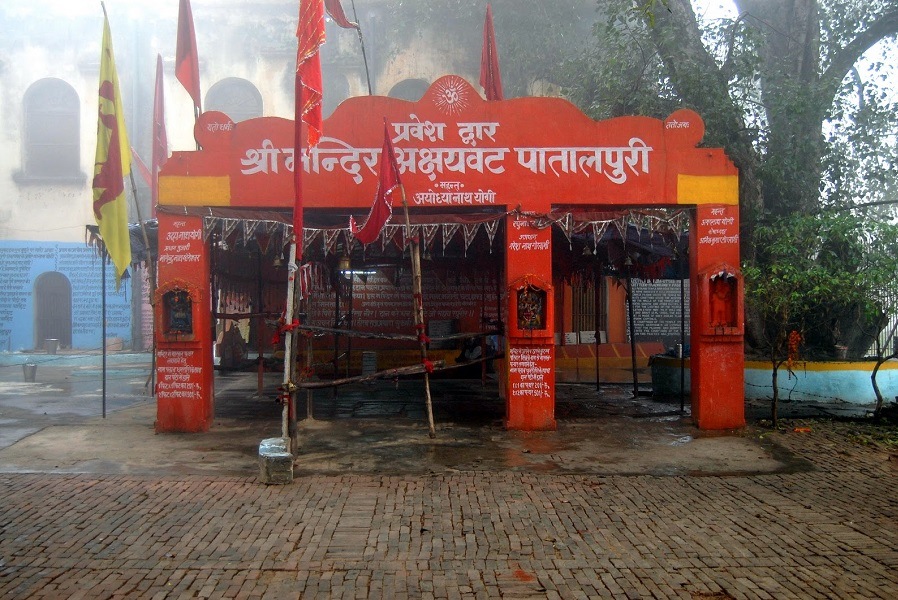Akshayavat Temple, Prayagraj - Timings, Festivals, History, Darshan, Pooja Timings
Photo Credit: Flickr
 #3 of 22 Places to Visit in Prayagraj
#3 of 22 Places to Visit in Prayagraj
 Distance (From Prayagraj): 6 Kms
Distance (From Prayagraj): 6 Kms
 Trip Duration (Including Travel): 1 Hour
Trip Duration (Including Travel): 1 Hour
 Transportation Options: Cab
Transportation Options: Cab
 Travel Tips: None
Travel Tips: None
About Akshayavat Temple
At a distance of 6 Km from Allahabad Railway Station, the Akshayavat Temple is an ancient Hindu temple situated near Sangam in Prayagraj, India. Situated within the ramparts of Allahabad Fort, the Akshayavat Temple, also referred to as Sri Adi Vat Madhav or Patalpuri Temple, derives its name from the 'Akshaya Vata,' an eternal Banyan tree that flourishes within its grounds. According to legend, this tree is immortal and indestructible, with an estimated age of over 3000 years. The revered Akshaya Vata tree is worshipped here as a manifestation of Lord Vishnu. It is one of the must-include places in the Prayagrag pilgrimage packages.
History of Akshayavat Temple
According to history, the Akshayavat tree is said to be immortal and indestructible, with an estimated age exceeding 3000 years. The current temple structure, which includes the vicinity of the Akshaya Vata, was integrated into the Allahabad Fort by Emperor Akbar in the 16th century. The Mughal rulers made significant efforts to eliminate the Akshayavat. In an attempt to undermine the religious beliefs and sentiments of Hindus, the Akshayavat was cut and burned 23 times, yet the Mughals were unsuccessful in their efforts to destroy it. After numerous instances of cutting and burning, the tree would revert to its original form. This prompted the decision to restrict access to the Akshayavat for Hindu pilgrims by constructing a large enclosure. Subsequently, the British utilized the fort as a base for weapon manufacturing. The colonial authorities not only maintained the ban on visits to the Akshayavat but also, after independence, the army was stationed in the fort, rendering the Akshayavat inaccessible to pilgrims. In 2019, during the Kumbh Mela in Prayagraj, the Akshayavat was opened for the viewing of ordinary devotees.
Mythology of Akshayavat Temple
The Akshayavat Temple is of considerable religious importance and is referenced in numerous ancient Hindu scriptures. It is believed that Lord Rama, accompanied by Lakshmana and Sita, visited this sacred site during his period of exile, and also performed Pind Daan (ancestor worship) for his father, Raja Dasharatha, at this location. Additionally, the temple's location along the banks of the Yamuna River in the Sangam area adds to its significance. Devotees believe that immersing themselves at the Sangam and offering prayers at the Akshayavat Temple will absolve them of sins and liberate them from the cycle of rebirth.
Architecture of Akshayavat Temple
Akshayavat Temple is situated below ground level, accessed through a tunnel and stairs from the fort's boundary wall. The temple complex encompasses several shrines dedicated to various Hindu deities. The principal shrine features the ancient Akshayavat tree, beneath which an idol of Lord Vishnu is enshrined within a small cave-like structure. The interior of this cave showcases intricate carvings that illustrate events from Hindu scriptures. Another notable shrine is devoted to the Navgrahas, the nine planetary deities. Separate temples are also present for Goddess Parvati, Lord Ganesha, Lord Hanuman, and Nav Durga. The temple's walls are adorned with murals and carvings depicting scenes from the Ramayana and Mahabharata. The expansive courtyard provides ample space for devotees and priests to conduct rituals and prayers.
Adjacent to the temple is the Saraswati Coup or Kamyakupa, an invisible holy well that was once believed to offer salvation to those who plunged into its depths. This well was later sealed by Emperor Akbar, leaving only its covered section visible. The well is opened to the pilgrims on the occasion of annual Magh Mela and Kumbh Mela period to enable them to have its 'darshan'. It is believed that the river Saraswati disappeared at this place.
Festivals of Akshayavat Temple
The Akshayavat Temple attracts large numbers of devotees and pilgrims, especially during religious festivals and important events. The Kumbha Mela, a grand Hindu pilgrimage that takes place every twelve years at the Triveni Sangam in Prayagraj, sees a huge influx of millions of people who come to bathe in the sacred rivers and receive blessings from Akshayvat.
Dress Code & Other Restrictions of Akshayavat Temple
Visitors to the Akshayavat Temple in Prayagraj are expected to dress in a modest and respectful manner, ensuring that their shoulders and knees are covered, as it is a sacred site. Men may opt for dhotis or long trousers paired with shirts, while women are encouraged to wear Sarees, Salwar Kameez, or other traditional attire. It is advisable to avoid Western clothing such as shorts, skirts, and sleeveless tops.
The Akshayavat tree is located within the Allahabad Fort, which is managed by the Indian Army. The general public is permitted to access the area, including the Patalpuri temple (where a representation of the Akshayavat is venerated) during the Kumbh Mela festival. Those wishing to visit the Akshayavat tree outside of the Kumbh Mela timeframe must seek permission from the army authorities.
Akshayavat Temple Timings
Monday: 7 AM - 6 PM
Tuesday: 7 AM - 6 PM
Wednesday: 7 AM - 6 PM
Thursday: 7 AM - 6 PM
Friday: 7 AM - 6 PM
Saturday: 7 AM - 6 PM
Sunday: 7 AM - 6 PM
Akshayavat Temple Entry Fee
Entry is Free
Best Time to Visit Akshayavat Temple
The best time to visit Akshayavat Temple is during the winter months from October to March, when the climate is cool and enjoyable for sightseeing. Travelers may also wish to plan their visit to align with the renowned Kumbh Mela, which occurs every 12 years, as well as the Ardh Kumbh Mela, taking place every six years from mid-January to early March. This period attracts thousands of individuals to the town for a sacred dip in the holy Sangam. The summer months in Prayagraj are characterized by heat and dryness, making it advisable to avoid this season. Conversely, the monsoon season is indeed the most favorable time to visit Allahabad, as the weather remains pleasant with minimal rainfall.
How to Reach Akshayavat Temple
Prayagraj is well connected by air, train and road. The nearest airport to reach Prayagraj is Allahabad Airport, located at a distance of 11 Km from the city and is connected to New Delhi, Mumbai, Indore, Pune, and Bangalore. Allahabad Railway Junction is well-connected by trains with Lucknow, Patna, Gorakhpur, Varanasi, Ghazipur, Kochi, Rameswaram, Mumbai, Gaya, Ajmer, Bangalore, Howrah, Darbhanga, Dibrugarh, Ranchi, Guwahati, Jharkhand, Jaipur, New Delhi, Hyderabad, Chennai, and Ayodhya. Allahabad can also be reached by road from all the major cities of Uttar Pradesh and New Delhi. Tourists can reach Akshayavat Temple by using buses, cabs, and auto rickshaws from all parts of the city of Allahabad.

























